Postpartum Hemorrhage(PPH) PowerPoint PPT Presentation
1 / 33
Title: Postpartum Hemorrhage(PPH)
1
Postpartum Hemorrhage(PPH)
- ????
- ???
2
Major causes of death for pregnancy
women(maternal mortality)
- Postpartum hemorrhage(28)
- heart diseases
- pregnancy-induced hypertension
- (or Amniotic fluid embolism )
- infection
3
Definition of PPH
- be defined as a blood loss exceeding 500ml after
delivery of the infant - PPH occurs in 24 hour of delivery
- the late PPH occurs after 24 hour of delivery
to 6 weeks
4
Major causes
- Uterine atony (90)
- lacerations of the genital tract(6)
- retained placenta(3-4)
- coagulation defects (blood dyscrasia)
- (4T tone, tissue,trauma,thrombin)
5
1. Uterine atony
- Local factors
- overdistention of the uterine (hydramnios,
multiple pregnancy, macrosomia ) - condition that interfere with contraction(leiomyom
as) - complications(PIH,anaemia, placenta praevia
6
- Systemic factors
- nervous
- drugs(magnesium sulfate,sedative)
- abnormal labor(prolonged,precipitous)
- History of previous PPH
- Preeclampsia, abnormal placentation,
7
pathology
- Contraction constricting the spiral arteries
- preventing the excessive bleeding from the
placenta implantation site - the uterine atony give rise to PPH when no
contraction occur
8
Prevention and therapeutic of uterine atony
- Administration of medicine
- promotes contraction of the uterine corpus
- decreases the likelihood of uterine atony
- Oxytocin agents
- Methegine
- prostaglandin
9
- Mechanical stimulation of uterine contraction
- Massage of uterus through the abdomen and
bimanual compression - intrauterine packing
10
(No Transcript)
11
(No Transcript)
12
(No Transcript)
13
Surgical methods
- If massage and agents are unsuccessful
- Ligation of the uterine arteries
- ligation of the hypogastric arteries
- selective arterial embolization
- hysterectomy
- taking into account the degree of
hemorrhage,the overall status of patient,her
future childbearing desires
14
2. Lacerations of the genital tract
- Causes
- Instrumented delivery (forceps)
- manipulative delivery(breech extraction,precipitou
s labor, macrosomia) - Types
- perineum laceration
- vaginal laceration
- cervical laceration
15
(No Transcript)
16
perineum and vaginal laceration
- The first degree tear
- involves only skin and a minor part of the
perineal body - the second degree tear
- involves the perineal body and vagina
- the third degree tear
- involves the anal sphincter and anal canal
17
(No Transcript)
18
(No Transcript)
19
(No Transcript)
20
management
- Vaginal examination soon after delivery
- repair
- cervical laceration gt2cm in length and be
actively bleeding - laceration of vaginal and perineum
21
3. Retained placenta
- Separation and explosion of placenta is caused by
strong uterine contraction - Placenta tissue remaining in the uterus
- prevent adequate contraction and predispose to
excessive bleeding
22
- causes
- adherence of placenta (previous cesarean
delivery,prior uterine curettage) - succenturiate placenta
- placenta accreta (into the decidua)
- placenta increta(into the myometrium)
- placenta pericreta(through the myometrium to the
peritoneal)
23
(No Transcript)
24
(No Transcript)
25
Prevention and treatment
- The placenta should be examined to see that it is
complete or not - part of placenta is missing, removed digitally
- not separated, manual removal of placenta is done
- hysterectomy is required for placenta
increta(percreta,accreta) - uterine contraction drugs
26
(No Transcript)
27
4. Coagulation defects
- Acquired abnormality in blood clotting
- abruptio placenta,
- amniotic fluid embolism
- severe preclampsia
- congenital abnormality in blood clotting
- thrombocytopenia
- severe hepatic diseases
- leukemia
28
disseminated intravascular coagulopathy(DIC)
- if bleeding persists in spite of all other
treatment described, DIC should be suspected - the blood passing from the genital tract is not
clotting - shock reduction of effective circulation
- inadequate perfusion of all
tissues - oxygen depletion
- depression of functions
29
- Record
- pulse
- blood pressure
- maternal heart rate
- central venous pressure
- urine output
30
- Lab tests
- Hb,
- BT(bleeding time), CT( clotting time),
- platelets count
- fibrinogen
- prothrombin time and patial thromboplastin time
- FDP
- womens group and cross-matching
31
- Treatment
- the key is correcting the coagulation defect
- resuscitation must be started as soon as
possible - infusion of crystalloid(saline) and Dextran is
started firstly while arranging the blood
transfusion - blood transfusion is essential
- infusion of platelets, fresh frozen plasma, FDP ,
clotting factors,
32
- Potential complications of PPH
- Postpartum infection
- Anemia
- Transfusion hepatitis,
- Sheehans syndrome
- Ashermans syndrome
- The best management of PPH is prevention
33
Key words
- the definitio n of HHP
- The causes of HHP
- treatment methods of Uterine atony
- the types of retained placenta
- the degrees of the perineal and vaginal
laceration

